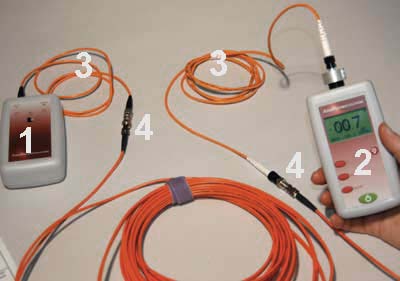A comprehensive overview to robotic vision in industrial automation
Wiki Article
All You Need to Understand About Robotic Vision and Its Applications in Advanced Optical Measurement Equipments
Robotic vision represents a substantial innovation in the junction of computer vision, expert system, and equipment knowing. This technology improves the accuracy of optical measurement systems, making it possible for real-time data analysis and boosted quality control. Its influence spans numerous sectors, from producing to medical care. The evolving landscape of robot vision increases concerns concerning future capabilities and applications. What advancements exist ahead in this transformative area?Recognizing Robotic Vision: Key Concepts and Technologies
Robotic vision includes the innovations and techniques that enable equipments to interpret and comprehend visual info from their setting. This area incorporates aspects of computer system vision, expert system, and equipment learning to facilitate automated decision-making based upon aesthetic information. Trick principles consist of photo handling, which entails the enhancement and evaluation of photos to extract significant functions, and things acknowledgment, which permits equipments to determine and identify items within a scene.
The Combination of Robotic Vision With Optical Dimension Systems
As markets progressively require precision and effectiveness, the assimilation of robot vision with optical measurement systems has arised as a transformative approach. This synergy permits robotics to regard and interpret their surroundings, improving the ability of optical dimension systems to analyze and analyze objects with unmatched accuracy. By gearing up optical sensing units with innovative imaging technologies, robotic vision enables real-time data collection and processing, assisting in prompt adjustments to measurement parameters.Additionally, the combination equips automated systems to find variations in measurements, surface quality, and alignment, which are crucial in high quality control processes. Improved formulas, such as machine discovering, more augment this combination by improving the systems' capacity to adapt to various settings and situations. The integration not just streamlines measurement processes but likewise lessens errors, making certain that products satisfy rigorous market standards, therefore solidifying the duty of robotic vision in the future of optical measurement systems.
Applications of Robotic Vision in Production
In contemporary manufacturing settings, using vision systems has actually reinvented production procedures by enabling equipments to do tasks with impressive precision and rate. Robotic vision systems are progressively used for quality assurance, where they inspect products for issues and assurance adherence to specifications. These systems use cameras and progressed formulas to evaluate items in real-time, considerably lowering the risk of human mistake.In addition, robotic vision assists in automation in production line, enabling robotics to accurately determine parts and assemble them with very little downtime. This modern technology also improves supply management, as vision systems can keep track of supply degrees and discover disparities, guaranteeing a seamless supply chain.
Robotic vision aids in the execution of smart manufacturing facilities, where data from vision systems can be incorporated with other modern technologies to maximize workflows (optical measurement system). Generally, the applications of robotic vision in making demonstrate its essential duty in improving effectiveness, quality, and efficiency throughout various sectors
Robotic Vision in Health Care: Revolutionizing Individual Care

In recovery, robot vision aids in keeping an eye on person progress and tailoring treatment sessions to individual needs. It sustains clinical experts by automating tasks such as information collection and client surveillance, allowing for even more time to concentrate on straight client interaction. Additionally, robot vision boosts telemedicine by allowing remote diagnosis and virtual appointments, connecting the void between individuals and doctor. In general, the application of robotic vision in health care is reinventing client care, leading to enhanced outcomes, performance, and patient satisfaction.
Future Trends and Growths in Robotic Vision Modern Technology
The rapid development of robotic vision modern technology promises to better enhance its applications across various fields, consisting of healthcare. Future fads suggest a considerable shift towards integrating synthetic knowledge and artificial intelligence, allowing systems to find out from huge datasets and boost accuracy gradually. Enhanced sensor technologies and deep discovering formulas are expected to improve item acknowledgment abilities, enabling robots to translate complex atmospheres better.
Moreover, the combination of augmented truth optical measurement system (AR) with robotic vision will likely transform exactly how robotics aid in procedures and diagnostics. This harmony will help with real-time information visualization, enhancing decision-making procedures. In addition, miniaturization of components will result in even more compact and functional robotic vision systems appropriate for a variety of jobs. As these improvements unfold, sectors will witness increased automation and performance, strengthening robot vision as a foundation of innovative technical services.
Frequently Asked Questions
What Are the Main Elements of a Robotic Vision System?
The main elements of a robot vision system consist of video cameras for photo capture, cpus for information analysis, algorithms for analysis, and actuators for activity. With each other, these components enable robots to perceive and connect with their environment successfully.Exactly How Does Robotic Vision Improve Accuracy in Measurements?
Robotic vision enhances dimension accuracy by utilizing advanced imaging technologies, enabling specific item detection and spatial analysis. This capability decreases human mistake, enhances repeatability, and permits for real-time adjustments, eventually boosting overall measurement dependability and performance.What Industries Benefit A Lot Of From Robotic Vision Innovation?
Different markets benefit considerably from robot vision modern technology, including manufacturing, health care, farming, and logistics. These markets utilize improved precision, effectiveness, and automation, causing enhanced productivity and reduced functional costs in their respective processes.Can Robotic Vision Solutions Operate In Low-Light Issues?
Robotic vision systems can indeed work in low-light problems, utilizing innovative sensing units and formulas to enhance image quality. This capacity allows them to perform effectively in different environments, including commercial and monitoring applications, despite having marginal illumination.What Are the Costs Related To Carrying Out Robotic Vision?
The costs connected with applying robot vision vary considerably, affected by parts such as cams, software application, and integration. Added costs consist of maintenance, training personnel, and potential upgrades to existing systems, which can accumulate gradually.Report this wiki page